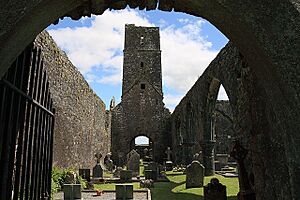Kilcrea Friary facts for kids
Quick facts for kids Kilcrea Friary |
|
|---|---|
|
Prióireacht Chill Chré
|
|

Kilcrea Friary
|
|
| Location | Ovens, County Cork |
| Country | Ireland |
| Denomination | Catholic Church |
| History | |
| Status | Ruined |
| Founded | 1463 or 1465 |
| Architecture | |
| Functional status | Friary |
Kilcrea Friary (Irish: Prióireacht Chill Chré) is a ruined medieval monastery in Ovens, County Cork, Ireland. Both the friary and Kilcrea Castle were built by Franciscans in the mid-1400s. They were built by Cormac Láidir MacCarthy, Lord of Muskerry. He wanted to protect the area from English troops.
The English army attacked the friary many times in the late 1500s. It was badly damaged but friars stayed there until the 1620s. Cormac MacCarthy died in battle in 1494 and is buried at the site. People still use the site as a burial ground today. Famous people buried there include Art Ó Laoghaire, who was the subject of a famous Irish poem.
The friary has a main church area, a side section called a transept, and cloisters. Cloisters are covered walkways around an open courtyard. The tall, narrow tower has steep, winding stairs inside. The rooms around the tower were once sleeping areas, day rooms, and kitchens.
The name Kilcrea comes from the Irish Cill Chré. This means "Cell of Cyra." Saint Cyra lived in the 6th century. She is said to have started a nunnery about a mile east of the friary. This area is now known as Ovens.
Contents
History of Kilcrea Friary
Kilcrea Friary was built in 1465 for the Franciscan monks. It was founded by Cormac Láidir MacCarthy, Lord of Muskerry. The friary was built on land that was already an old Christian site. It is in the valley of the River Bride.
The friary is named after Saint Cyra, a holy woman from the sixth century. Legend says she was the leader of the original nunnery here. She might even be buried in the middle of the choir area. The friary and nearby Kilcrea Castle are now in the countryside. But long ago, they were likely part of an old town.
English soldiers first attacked Kilcrea in 1542. They also raided it in 1584. But the friary continued to be used with MacCarthy's help. In 1597, it was given to Cormac MacDermot MacCarthy. The friary was repaired twice, including in 1604. It stayed active until the 1620s.
The grounds have been used for burials since the early 1600s. Most burials are in the graveyard within the ruined church. It was the burial place for the McCarthy family from 1494 to 1616. Cormac MacCarthy was the first of his family buried here. There are no clear signs of their tombs left today. A carved head on the tower's upper floors might be a picture of Cormac MacCarthy.
What Kilcrea Friary Looks Like
Kilcrea Friary is made up of several buildings around a main church. Even though it is a ruin, much of the abbey is still standing. This includes its tower, the cloisters, and the buildings around them.
The abbey's church has a nave (the main part), a chancel (the area near the altar), a transept (a part that crosses the main church), and an L-shaped aisle (a side passage). You enter the church through a doorway on its west side. A row of arches separates the nave from the south aisle and transept.
The chancel has a large window on its east wall. This window has lost its original decorative stone work. There are four other windows on the south wall. These windows once held single or double glass panes. There is no sign of the main altar, which was probably under the east window. But a small arched basin for holy water is nearby in the south wall.
Next to the chancel is the sacristy, a room where priests prepare. This room was added in the 1500s. Above it is the scriptorium, a room where monks copied books.
The cloister area is north of the church. The covered walkways of the cloister are gone. But the two-story buildings around it are still well-preserved. The remains of the chapter room (where monks met) and the refectory (dining hall) are on the east side. The sleeping areas (dormitories) are above these rooms. Some old records suggest the friary had an infirmary (a place for the sick). But its exact location is unknown.
The scriptorium was a large room, about 39 by 17 feet. It was probably also used for studying. This room was the brightest on the site. It has 11 tall windows with two lights (panes) each.
Outside the main doorway, there is a space for a holy water font. Above the doorway, there are also remains of a large window with three lights.
The tower has four levels. Each level had wooden floors supported by stone brackets called corbels. Each level was lit by simple, narrow windows. The very top level has a single window with a special S-shaped curve called an ogee arch. The tower is wider at its base to make room for the stairs.
A book written at Kilcrea in the 1400s is now kept in Rennes, France.
Important People Buried Here
- Cormac Laidir MacCarthy (1411–1494), the 6th Lord of Muskerry
- Thomas O'Herlahy, a Catholic Bishop of Ross (1561–1579)
- Art Ó Laoghaire (1746–1773), the main person in the famous poem "Caoineadh Airt Uí Laoghaire"
See also
 In Spanish: Monasterio de Kilcrea para niños
In Spanish: Monasterio de Kilcrea para niños




